What Makes the 1994 Penny Valuable?
While most 1994 pennies are only worth their face value, certain features can make them appealing to collectors.
Start by checking for a mint mark. Coins struck in Philadelphia (no mint mark), Denver (D), and especially San Francisco (S) can be more desirable, depending on their type and condition.
Next, examine the coin carefully for any mint errors, such as off-center strikes, doubled dies, or other anomalies. These rare mistakes can add considerable value.
The condition of the coin is also important. Circulated pennies usually don’t carry a premium. But those in mint state (MS)—especially with a bright red surface—can fetch much higher prices.
Finally, rarity plays a major role. Lower-mintage or high-grade proof coins and uncirculated specimens are worth significantly more than typical pocket change.
1994 Penny Value Chart
| Coin | MS65 | MS66+ | MS68 | MS68+ | MS69 | PR/PF70 DCAM |
|---|---|---|---|---|---|---|
| 1994 No Mint Mark Penny | $10 | $18 | $215 | $1,600 | $13,000 | – |
| 1994-D Penny | $10 | $16 | $100 | $400 | $3,750 | – |
| 1994-S Proof Penny | $4 | $5 | $7 | $8 | $14 | $38 |
All prices reflect values for coins graded Red, which is the most desirable color designation for copper coins.
History of the 1994 Penny

Is the 1994 Penny Worth Collecting?
At this point, the U.S. penny is more symbolic than practical. It costs nearly 3 cents to mint a single coin, and you can’t really buy anything with it anymore. Still, the bright copper-red color makes it visually appealing—especially compared to most coins in circulation that have a dull, silver or fake-gold appearance.
Beyond that, it’s a sentimental favorite. It’s one of the few coins cheap enough for kids—even toddlers—to start collecting. But if you’re wondering whether the 1994 Lincoln penny has any real investment value, the answer is: not much.
Before we dig into the coin’s worth, let’s take a quick look at its background.
A Short History of the Lincoln Cent
The Lincoln penny was first introduced in 1909, replacing the Indian Head cent. It was the first circulating U.S. coin to feature a real person—specifically, a U.S. president. That marked a major shift in policy. For years, founding fathers like George Washington and Benjamin Franklin had resisted having their images used on money, believing it was too similar to monarchy.
Ironically, once Abraham Lincoln appeared on the penny, Washington and Franklin soon followed, appearing on other coins in the years to come.
The Lincoln cent also aligned with President Theodore Roosevelt’s mission to make American coinage more beautiful and meaningful. His push for coin redesigns led to presidential portraits being added to multiple denominations.
From Wheat to Memorial: How the Design Evolved
The original Lincoln cent was designed by Victor David Brenner, who took over after the death of his mentor, Augustus Saint-Gaudens. Saint-Gaudens had designed a walking Lady Liberty for the cent, but the U.S. Mint repurposed that design for the $20 Double Eagle gold coin.
Brenner was tasked with creating a Lincoln portrait for the obverse (heads side). For the reverse, he initially proposed a tree branch inspired by French coinage, but that idea was rejected. Instead, he opted for durum wheat stalks, giving rise to the iconic Wheat Cent design.
In 1959, to celebrate 150 years since Lincoln’s birth, the reverse was changed to the Lincoln Memorial, designed by Frank Gasparro—a look that remained until 2008.
What Makes the 1994 Penny Unique?
By 1994, the Lincoln cent still featured Lincoln on the front and the Memorial on the back. But unlike earlier versions that were 95% copper, the 1994 penny contained only 2.5% copper, with the remaining 97.5% made of zinc. The copper was kept only for plating, to maintain the coin’s familiar appearance.
This change was a cost-cutting move due to the rising price of copper. But despite the adjustment, the penny’s production cost still ended up being higher than its face value.
Features of the 1994 Penny
The Obverse of the 1994 Penny
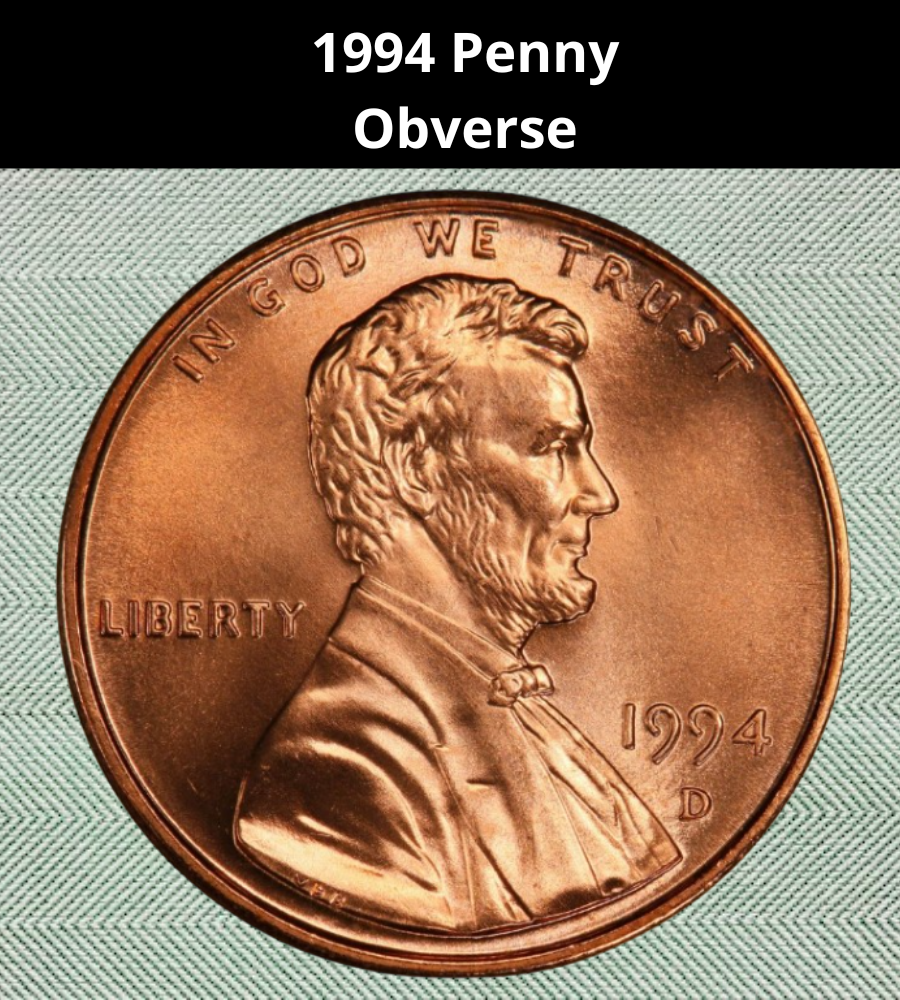
The front (obverse) of the coin features a right-facing portrait of Abraham Lincoln. The phrase “IN GOD WE TRUST” is displayed along the top edge above his head, while the word “LIBERTY” appears on the left side, just behind Lincoln’s back. On the right side, in front of his chest, you’ll see the year of minting along with the mint mark (if present). At the bottom edge of his shoulder, you’ll find the initials “VDB”, honoring the coin’s original designer, Victor David Brenner.
The Reverse of the 1994 Penny
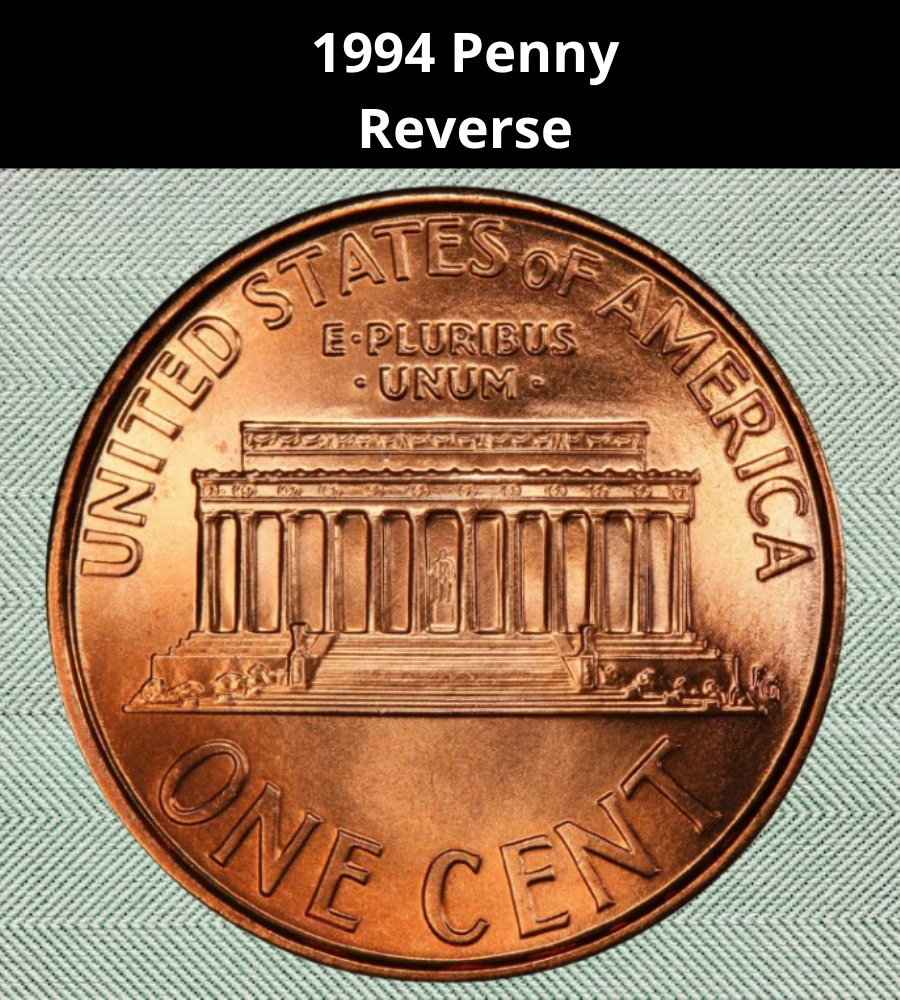
The reverse of the coin presents a head-on view of the Lincoln Memorial, with the statue of Lincoln visible through the center columns. On the right side of the steps, the initials “FG” are engraved, representing Frank Gasparro, the coin’s reverse designer. Along the top edge, the inscription reads “UNITED STATES OF AMERICA”, with “E PLURIBUS UNUM” positioned just above the Memorial’s roof. At the bottom of the coin, you’ll find the denomination: “ONE CENT”.
Other Features of the 1994 Penny
The 1994 Lincoln penny is composed of 97.5% zinc with a thin outer layer of 2.5% copper, giving it the classic copper appearance. Each coin weighs approximately 2.5 grams and has a diameter of 19.05 millimeters. The edge of the coin is smooth—it has no reeding or ridges. Due to its copper coating, the coin’s coloration can vary, typically falling somewhere on a spectrum from bright red (when uncirculated) to reddish-brown, and eventually dark brown as it ages and oxidizes.
1994 Penny Grading Guide
Like all U.S. coins, the 1994 penny is evaluated using the Sheldon Scale, which ranges from 1 to 70. A grade of 1 represents a heavily worn, barely identifiable coin, while 70 designates a flawless, Mint State specimen. Generally, any coin graded above 50 is considered Uncirculated.
In addition to numerical grading, Lincoln cents are also classified by color, which plays a major role in value. The three standard color designations are:
- Red (RD) – Indicates that at least 95% of the original red copper luster is intact. This is the most desirable color.
- Red-Brown (RB) – Represents coins with a mix of red and brown surfaces, typically 5% to 95% red.
- Brown (BN or BRN) – Coins that are mostly or entirely brown, usually from age and oxidation.
Here’s a quick reference to how grades are categorized:
| Grade # | Classification |
|---|---|
| 1 | Basal State |
| 2 | Fair |
| 3 | Very Fair |
| 4–6 | Good |
| 7–10 | Very Good |
| 12, 15 | Fine |
| 20, 30 | Very Fine |
| 40 | Extremely Fine |
| 50 | About Uncirculated |
| 60 | Mint State (MS60) |
| 65 | Gem Mint State (MS65) |
| 70 | Perfect Mint State (MS70) |
Tip: If you’re unsure of your coin’s grade, consult a professional grading service or refer to detailed guides. Proper grading is essential to determine a 1994 penny’s market value.
1994 Penny Value Guide
1994 No Mint Mark Penny Value
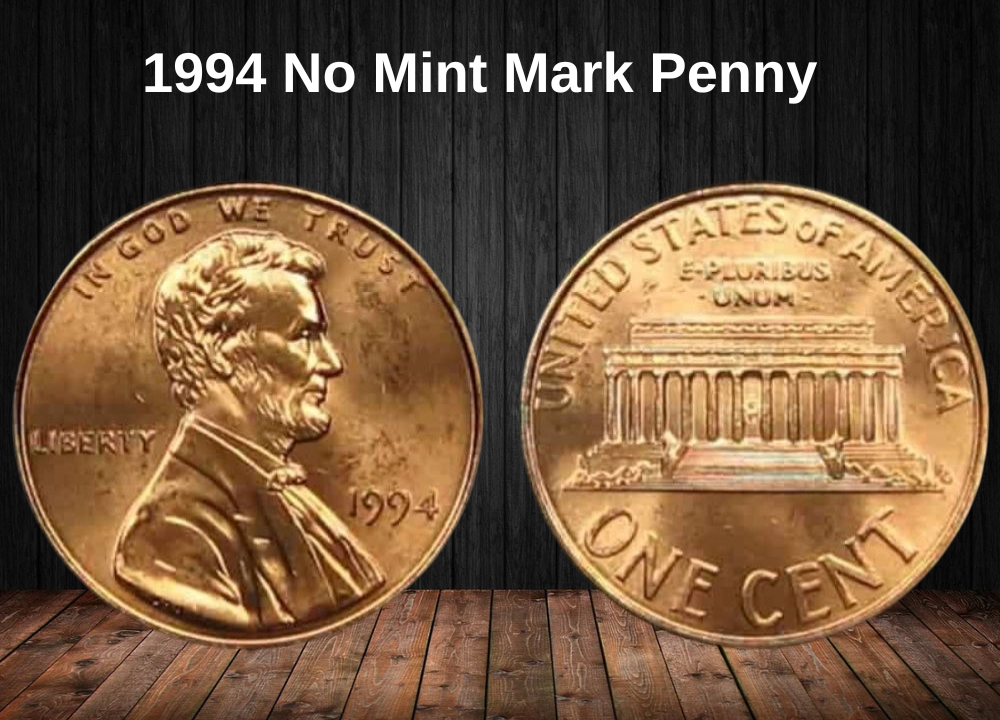
In 1994, the Philadelphia Mint struck over 6.5 billion Lincoln pennies—specifically 6,500,850,000 coins without a mint mark. With such a high mintage, these pennies are generally very common and only hold significant value in exceptionally high grades or with rare features.
While places like eBay offer a platform to buy and sell, keep in mind that listing prices aren’t always reflective of true market value. For example:
- On October 21, 2021, a seller managed to sell a 1994 MS69 Brown (BN) penny for $195.
- Interestingly, back on July 30, 2003, an MS62 Red (RD) example sold for a much higher $1,035—despite being a lower grade.
As of now, pricing is more stable and better defined:
- MS65 Red (RD): Around $10
- MS69 Red (RD): Valued at approximately $13,000
This sharp price gap highlights how crucial grade and color designation are when determining a penny’s worth. For serious collectors, only the highest-grade red coins from 1994 command substantial premiums.
1994-D Penny Value
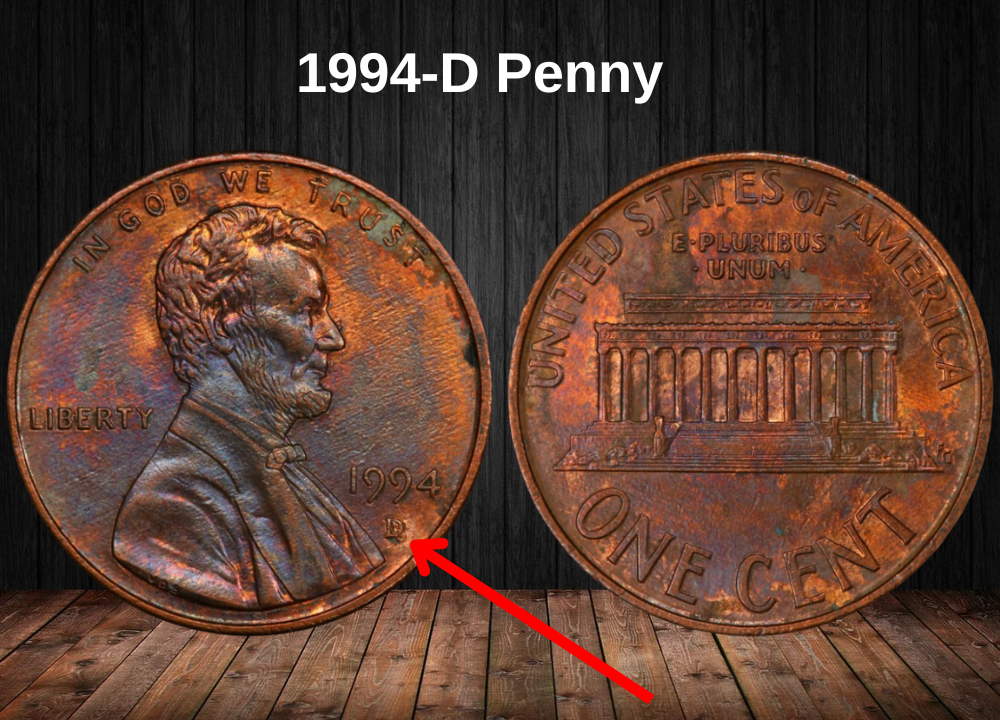
In 1994, the Denver Mint produced 7,131,765,000 Lincoln pennies, each bearing the “D” mint mark just below the date on the obverse. With such a massive mintage, most of these coins remain common today, and their value depends heavily on condition and color.
Back on September 22, 2010, a 1994-D penny graded MS68 Red (RD) sold for $633 at auction. However, by 2025, over 150 examples in that same grade have been certified, significantly lowering the market value to around $100.
Rarity increases at higher grades:
- The only known MS68+ RD example is now estimated at $400.
- Just four coins have been certified at the near-perfect MS69 RD grade, and each of these is valued at approximately $3,750 in 2025.
So while the majority of 1994-D pennies are only worth face value, high-grade red specimens remain highly collectible and can command premium prices.
1994-S Proof Penny Value
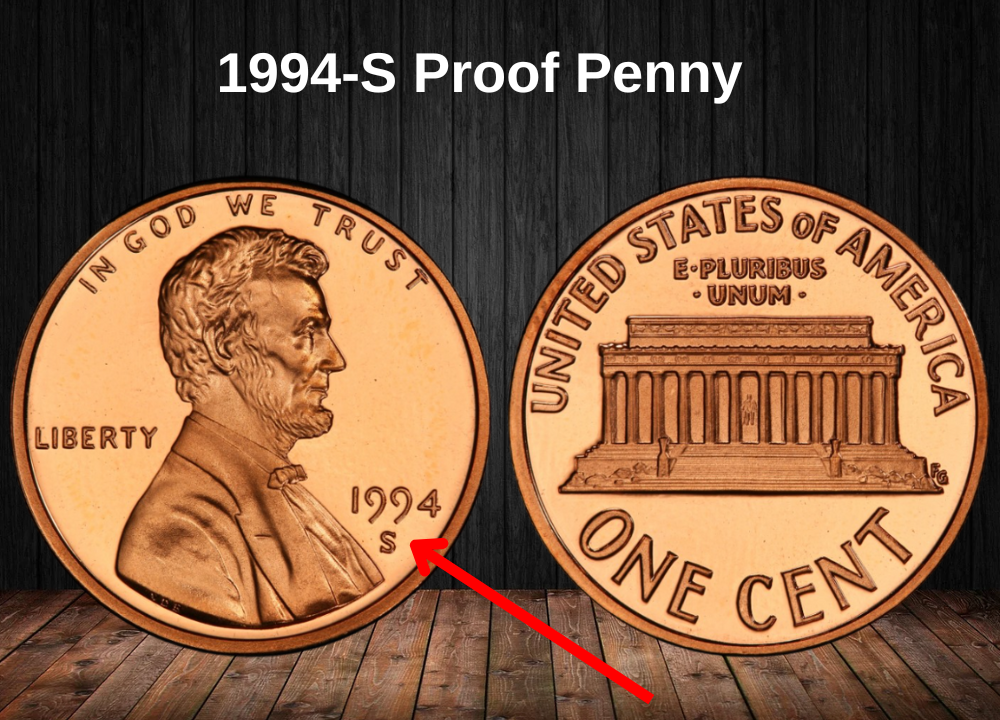
The earliest Lincoln Proof Pennies featured a matte finish created by sandblasting—a French technique used because the original Lincoln design was too detailed and curved for standard minting. Starting in 1936, the U.S. Mint developed mirror-like proof pennies using specially prepared proof dies. The glossy areas were achieved by scrubbing the dies with horsehair brushes, while the frosted details were applied either through acid pickling or, later, laser etching.
The 1994-S Proof Penny represents an ultra-modern example, textured with precise computer-controlled lasers. Thanks to this advanced process, all 1994-S proof pennies retain their Deep Cameo (DCAM) or Ultra Cameo appearance, showing strong contrast between frosted designs and mirror-like fields.
In contrast, earlier acid-washed proofs lost their frosted finish after repeated strikes; by the 100th coin, the contrast would fade to normal Cameo and then to standard proof finishes in red, brown, or red-brown tones.
The San Francisco Mint produced 3,269,923 of these 1994-S pennies, each bearing the “S” mint mark.
Twenty years ago, a PR70 Deep Cameo 1994-S penny sold for $1,955 on November 21, 2002. Since then, more than 850 coins have been graded at this level by PCGS, increasing supply and lowering their market value to about $38 today, despite being the highest possible grade.
Similarly, nearly 9,331 PR69 Deep Cameo coins have been submitted to PCGS, making this grade more common and valued at approximately $14 as of May 2025.
Rare 1994 Penny Errors List
1994 (P) Penny DDR
DDR stands for doubled-die reverse, a minting error caused when the die shifts slightly between hub strikes. This results in a distinctive doubling or “ghosting” effect on the coin’s design, which appears on all coins struck from that particular die.
For the 1994 Philadelphia penny DDR, the doubling is most noticeable on the columns of the Lincoln Memorial on the reverse side.
On June 17, 2010, an MS66 Red example sold for $2,875. As of today, a higher-grade MS67 Red is valued at approximately $2,050.
1994 (P) Penny Incomplete Plating Error

Most American coins have a copper core with a cupronickel outer layer, but pennies are the opposite: they have a zinc core with a thin copper coating. Sometimes, this copper cladding wears off, exposing splotches of the grey zinc underneath on both sides of the coin.
One such 1994 penny, graded MS64 Red, showed this copper loss and sold for $95.
1994-D Penny Unplated Error
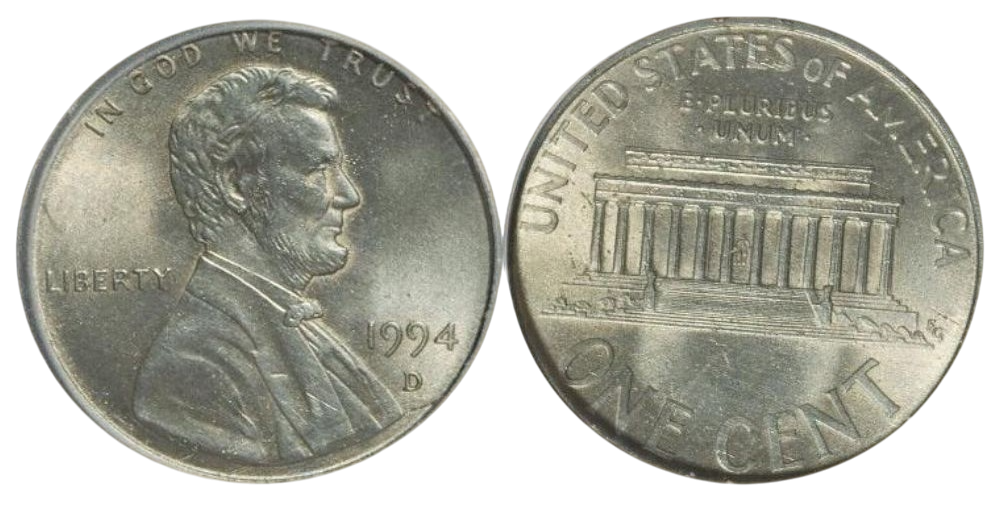
On the previous coin, only three sections had their copper plating washed off. However, this coin is completely unplated on both sides, revealing the inner zinc core throughout. While it’s certainly eye-catching, it isn’t particularly valuable—an MS65 graded example sold for around $150. Because of its all-zinc appearance, it can be mistaken for a Steelie penny (1942–1944) or an aluminum penny, so be sure to check the mint date carefully.
1994 (P) Penny Broadstruck Error
The retaining collar, or rim, of a coin is essential for maintaining consistent shape, thickness, and stackability. Occasionally, the collar becomes deformed during striking, causing the rim to appear thinner and flatter than usual. This error is known as a broadstrike. A 1994 (P) penny with this error, graded MS64 RD, sold for $65.
1994 (P) Penny Overstruck on a 1994-P Dime
In this rare error, a 1994 penny was struck over a 1994 dime planchet, but with the dime rotated and flipped before the penny dies struck it. This created a double denomination coin where the designs are back-to-front. You can see traces of the “One Dime” inscription under Lincoln’s portrait. Graded MS66, this coin sold for $1,495.
1994 (P) Penny Struck on a Dime Planchet
Unlike the previous examples where the penny was struck on an already struck dime, this error occurred when a penny was struck on an unstruck dime planchet. Because dimes are smaller, part of the penny’s design was cut off. Additionally, the coin’s weight (2.26g) and color were incorrect. This error sold for $750 in MS66.
1994 Penny Double Struck Error
Coins often receive multiple strikes to ensure detail, but if the coin shifts between strikes, a double strike error occurs. For example, a 1996 (P) MS62 RD coin with an 85% off-center strike sold for $45. Another MS62 RD at 70% off-center was valued at $180, while a 1996-D MS64 RD at 75% off-center sold for $150.
1994 (P) Penny Off-Center Error
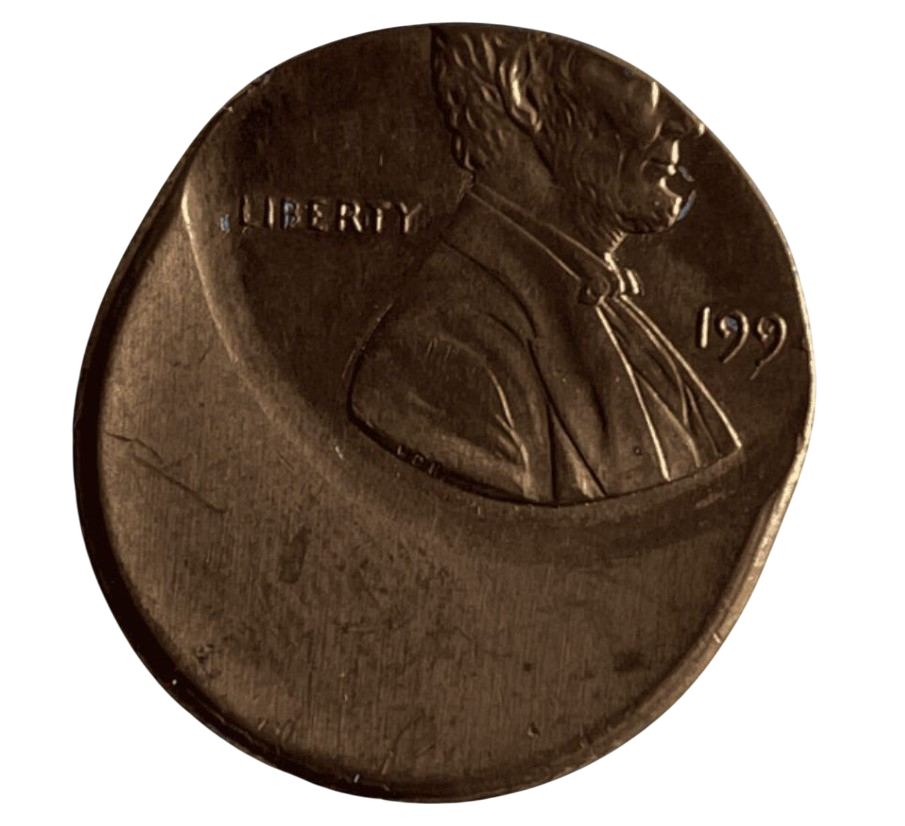
Double strikes and off-center errors both occur when the coin or planchet shifts while the dies are raised. However, with off-center errors—also called misalignments—the planchet moves before the first strike, leaving a portion of the coin blank and unmarked.
For example:
- A 50% off-center penny without a grade sold for $17 on eBay.
- A 25% off-center MS65 RD graded coin sold for $36.
- A 70% off-center MS62 RD graded coin fetched $40.
1994 (P) Penny Rotated Die Error
Normally, the obverse and reverse dies strike the planchet simultaneously and are aligned 180° apart, so flipping the coin vertically keeps both sides upright. On this coin, however, one die rotated slightly, causing the design to appear slanted when the coin is flipped. This error isn’t highly valuable—an ungraded example sold for $27.57 on eBay.
1994 (P) Penny Foldover Error
Coins are fed between the dies by feeder fingers at a rapid pace. Occasionally, the blank lands on its edge instead of flat, so when struck, it gets folded into a half-circle shape—known as a foldover error. A 1994 (P) penny with this error graded MS 66 RD sold for over $1,100.
Where to sell your penny?
Now that you know the value of your penny, you might be wondering where to sell it. Don’t worry: here’s a guide to some of the best online platforms where you can easily sell your coins, along with their advantages and disadvantages.
Discover the best platforms for selling coins online (pros and cons).
1994 Penny FAQ
1. What are the most significant error varieties of the 1994 penny, and how do they impact its collectible value?
Error coins like doubled dies or off-center strikes from 1994 can greatly increase value, but understanding which specific errors exist and their rarity is key for serious collectors.
2. How did the shift to a primarily zinc core in pennies by 1994 affect the coin’s durability and long-term condition?
The 1994 penny’s zinc core makes it more susceptible to corrosion and wear compared to earlier mostly copper pennies, influencing how collectors grade and preserve these coins.
3. What subtle differences exist between the 1994 pennies minted in Philadelphia and Denver, and how do these affect their desirability?
Though visually similar, small variations in die wear, strike quality, and mint mark placement can create differences sought after by specialists completing mint sets.
4. How did the economic conditions of the early 1990s influence the U.S. Mint’s production priorities for coins like the 1994 penny?
Examining the economic context provides insight into why certain minting decisions were made, including production volume and quality control.
5. In what ways do proof and uncirculated 1994 pennies differ technically and visually from circulated examples?
Proof coins have distinct finishes and sharper details that appeal to collectors, while uncirculated examples preserve mint condition without wear.
6. How has the market demand for 1994 pennies evolved among collectors, especially for error and proof coins?
Market trends reflect collector interest, rarity, and condition factors that shift value over time.
7. Are there any notable discoveries or anecdotes within the numismatic community related to 1994 pennies that highlight their significance?
Stories of rare finds or auction results can reveal the cultural and historical importance collectors place on these coins.


















































